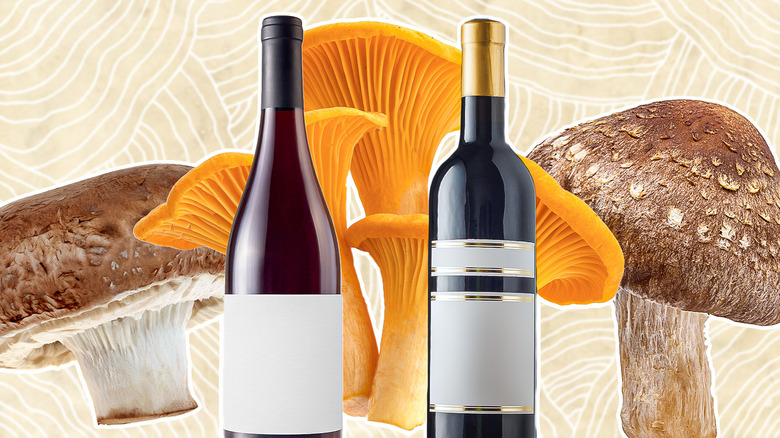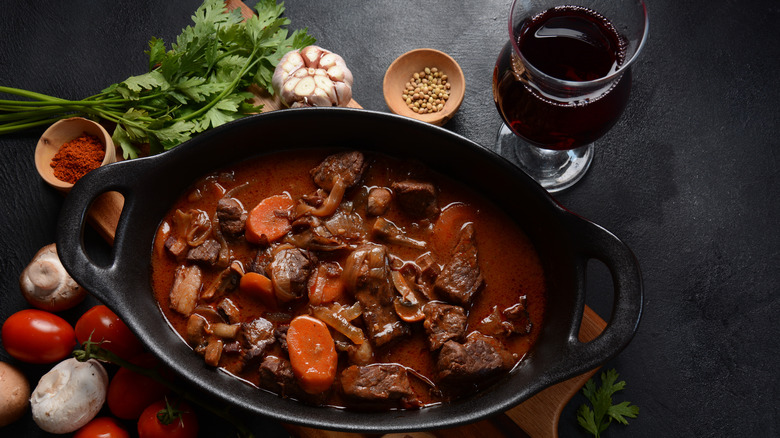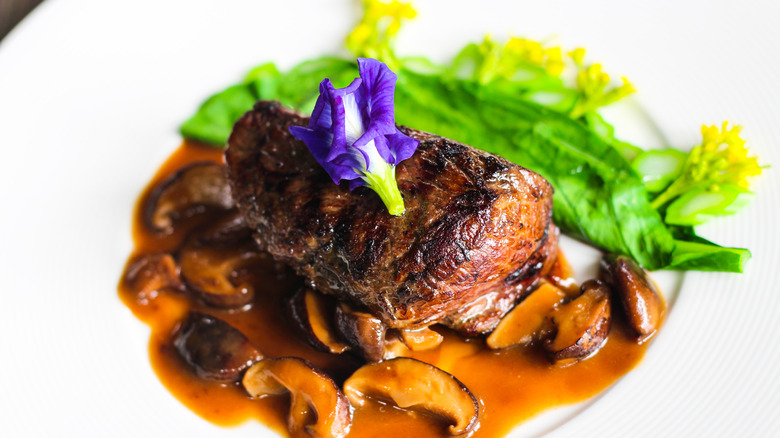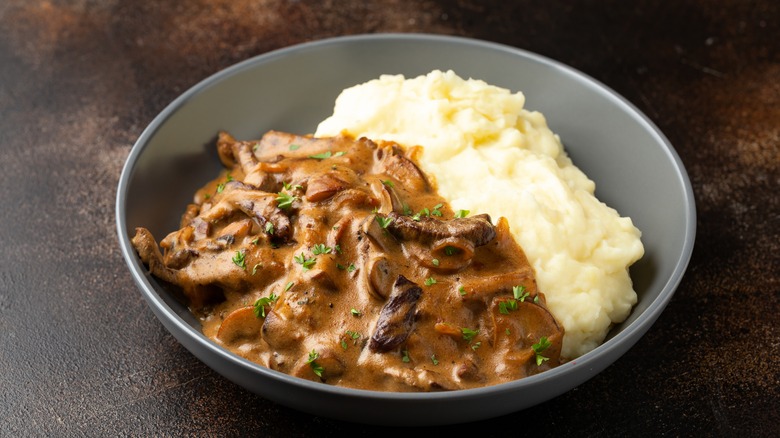A Chef-Approved Guide To Pairing Mushrooms And Wine In Savory Sauces
While pairing wine with a specific meal is a longstanding tradition that mutually benefits both the drink and the food, the same concept applies when using wine as an ingredient in savory sauces. Mushrooms are arguably one of the most savory, umami-rich sauce components that the right wine pairing will really enhance. That said, there are dozens of types of mushrooms and even more types of wine. Luckily, an expert chef has given us a thorough guide to pairing mushrooms and wine in sauces.
In an interview with Tasting Table, Kieron Hales, chef and co-owner of the Michigan wedding venue Zingerman's Cornman Farms, proclaims, "By considering the specific characteristics of the mushrooms you're using, you can select a wine that enhances your sauce." The characteristics Hales refers to are the texture, flavor, and intensity of the mushroom in question.
In a comprehensive guide to wine and mushroom pairings, Hales' strategy is to match the intensity of a mushroom's flavor with an equally intense, full-bodied wine while also choosing a wine with tasting notes that complement the earthy umami-richness of the specific mushroom. He asserts that by choosing the best wine and mushroom pairing in a sauce, you're effectively "creating a more cohesive and flavorful dish." Whether you're adding mushrooms to a bordelaise sauce for steak, a hearty beef stew, or an elegant coq a vin, Hales' handy guide will help you make the most of your dish.
Delicate Mushrooms
Chef Hales breaks his guide down by categorizing mushrooms according to intensity and flavor profiles, then explaining which types of wine pair best with each mushroom category. He starts with the most delicate mushrooms, including chanterelles, morels, and oyster mushrooms. He says, "These mushrooms have a subtle, nuanced flavor with a hint of sweetness or nuttiness." Mushrooms in this category also have a delicate texture that is often described as velvety or soft, making them great additions to wine sauces and cream sauces alike. Furthermore, each type of mushroom has distinct tasting notes: Oyster mushrooms (which can be seared until crispy) have oceanic or seafood notes along with subtle notes of anise, morels are nutty and woodsy, and chanterelles have a sweet aroma and both peppery and fruity tasting notes.
Hales recommends matching their delicate flavor with equally light, subtle red wines like pinot noir or gamay, whose "fruitiness and earthy undertones can enhance the mushroom's natural flavors." Both pinot noir and gamay are medium-bodied, dry, and acidic wines with notes of red fruits and vanilla. Gamay has a slightly more floral flavor, while many pinot noirs often list mushrooms as some of their earthy tasting notes. According to Hales, the gentle flavor and fruity tasting notes "can complement these flavors without overpowering them."
Medium-flavored Mushrooms
Hales categorizes cremini, button mushrooms, and shiitake mushrooms as medium-intensity ingredients with stronger earthy and umami flavors as well as more complexity than the mushrooms in the delicate category. For example, shiitake mushrooms are the height of earthy and savory, but they incur a smoky flavor when cooked. Cremini and button mushrooms are on the nuttier side with a buttery richness. Medium-flavored mushrooms also have a chewier, more substantial texture.
Hales says, "Medium-bodied red wines with a good balance of fruit and earthiness work well with these mushrooms." To optimize the palate of these mushrooms in a sauce, he recommends merlots that tend to taste of "black cherry and plum with earthy notes, or a lighter Syrah/Shiraz with its spicy, slightly peppery flavors." Shiraz and merlots are both dry, less acidic, and fuller-bodied than pinot noirs. However, the two have very different tasting notes, which may pair well with mushrooms but can take your sauce in two different directions.
Robust Mushrooms
Hales' final category includes mushrooms with "a rich, meaty texture and a deep, robust flavor profile." This robust mushroom category includes the likes of porcini, trumpet, and portobellos. Their hearty, juicy consistency and concentrated umami flavors make them favored meat substitutes in burgers, tacos, pot roasts, or even as a standalone main course when grilled or oven-roasted like a fancy steak. Just as red meat marinades and sauces often call for equally robust flavors, the same concept applies to wine pairings.
Hales explains, "Full-bodied red wines such as cabernet sauvignon, zinfandel, or a robust syrah/shiraz can stand up to these strong flavors." Wines with high levels of bitter tannins and complex flavors from the type of grape and aging vessel are the best candidates to stand up to and harmonize with the meatiness and richness of the mushrooms in this last category. They all have more diverse tasting notes, with equal parts fruit, spice, and often earthy or smoky notes like tobacco or wood. Zinfandel, for example, is a popular pairing for beef stroganoff, to which you can swap or add equally meaty porcini mushrooms.



